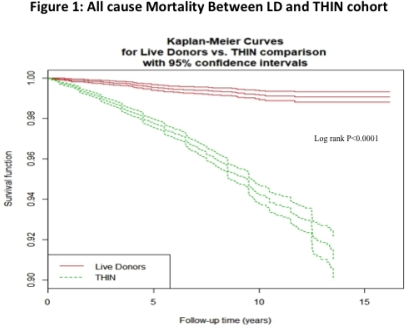Mortality of Live Kidney Donors in the UK: 15 Year Comparative Cohort Study
1Renal Unit, University Hospitals Coventry & Warwickshire NHS Trust, Coventry, United Kingdom
2Faculty of Health and Life Sciences, Coventry University, Coventry, United Kingdom
3Statistics and Clinical Studies, Organ Donation and Transplant, National Health Services Blood and Transplant, Bristol, United Kingdom
4Renal Unit, Queen Elizabeth Hospital, Birmingham, United Kingdom
5Renal Unit, Heartlands Hospital, Birmingham, United Kingdom
6Unit of Academic Primary Care, University of Warwick, Coventry, United Kingdom
7Primary Care, Primary Care, West Midlands, Birmingham, United Kingdom
8Statistics, University Hospitals Coventry & Warwickshire NHS Trust, Coventry, United Kingdom.
Meeting: 2018 American Transplant Congress
Abstract number: B162
Session Information
Session Name: Poster Session B: Kidney Living Donor: Long Term Outcomes
Session Type: Poster Session
Date: Sunday, June 3, 2018
Session Time: 6:00pm-7:00pm
 Presentation Time: 6:00pm-7:00pm
Presentation Time: 6:00pm-7:00pm
Location: Hall 4EF
To investigate the all-cause mortality o LDs in comparison with healthy controls.
Ethics approval was in place to accrue data from database. Protocol reviewed and passed by Renal Registry projects advisory group, and independent scientific review committee, before release of data.
Cohorts: A) LD: Dataset obtained from UK Transplant Registry, NHSBT, U.K. All live kidney donors from January 1st 2001 to 31st December, 2013 included and end date was 31st December 2016 . B) Comparative Cohort, The Health Improvement Network (THIN) : This is large UK general practice database which contains anonymized longitudinal patient records from over 500 practices. Data collected stratified by age, gender, year of entry, excluding a number of baseline conditions that would have been a contraindication to donation.
Figure shows significant difference in mortality between the LD and the THIN cohort, with the LD group doing better. Cox PHModelling showed that hazard ratio was significantly more for the THIN group even after adjustments for confounding variables. Further analyses were conducted to examine mortality for different age bands. This showed that there was no difference in 18-29 years age group, but statistically significant differences emerged with longer durations of follow-up in the other age groups; 30-44 years (P= 0.01), 45-59 years (P<0.001) and >60 years (P<0.001).
There was no increased risk of mortality in the LD group compared to a healthy cohort on analysis of a 15-year UK database.
CITATION INFORMATION: Krishnan N., Mumford L., Lipkin G., Fletcher S., Gupta I., Gill P., Ryan R., Raymond N. Mortality of Live Kidney Donors in the UK: 15 Year Comparative Cohort Study Am J Transplant. 2017;17 (suppl 3).
To cite this abstract in AMA style:
Krishnan N, Mumford L, Lipkin G, Fletcher S, Gupta I, Gill P, Ryan R, Raymond N. Mortality of Live Kidney Donors in the UK: 15 Year Comparative Cohort Study [abstract]. https://atcmeetingabstracts.com/abstract/mortality-of-live-kidney-donors-in-the-uk-15-year-comparative-cohort-study/. Accessed January 7, 2026.« Back to 2018 American Transplant Congress

